The Golden Gate is very much in the news today, as it has become a point of conflict between Jews and Muslims, or Palestinians and Israelis.
But what do we know about this gate?
The Golden Gate, around which swirl various traditions, is the most intriguing of all the gates of the Temple Mount. In Jewish tradition, it is through this gate (Sha’ar haRachamim—Gate of Mercy), blocked since the ninth century, that Messiah will enter at the end of days, led in by the prophet Elijah. This is based on the prophecy of Ezekiel 44.1–3. Christians believe that Christ made his triumphal entry into Jerusalem (recorded in all four of the gospels) through this gate on the Sunday before his crucifixion (Palm Sunday). By riding on a donkey, he fulfilled the messianic prophecy recorded in Zechariah 9.9. Muslims refer to it as the Gate of Eternity (Bab-al-Dahariyeh) and believe it will be an important part of the last judgment of mankind. The Muslim cemetery along the Eastern Wall is thought to have been placed there in the belief that the forerunner of Messiah, Elijah, being of a priestly family, could not pass through the Golden Gate, thus preventing the coming of the Messiah.
Some claim that the Golden Gate was built by the Byzantine emperor Heraclius after the expulsion of the Sassanians from Jerusalem. However, the absence in the architectural decorations of any Christian symbols, such as a cross makes that difficult to believe. There are actually four distinct historical phases represented in the architecture of this gate: Turkish, Umayyad, Herodian and First Temple period. In the 1970’s I was privileged to spend one week inside this gate, measuring and recording its plan and drawing accurate elevations of all the interior surfaces.
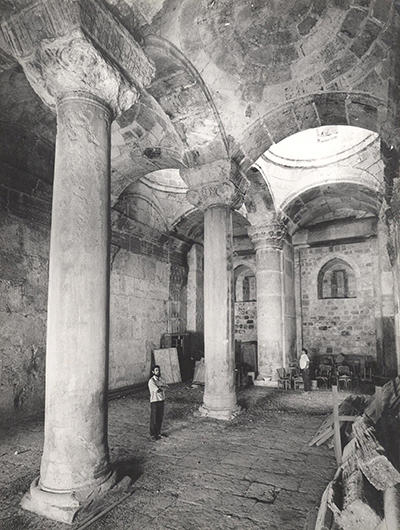
The Golden Gate’s outer façade is composed of two blocked-up gateways adorned with intricately carved relief arches. The decoration of the arches to the front and back of the gate are identical to the applied arches of the Double Gate which date from the Early Islamic period. The gate appears therefore to have been rebuilt in the Umayyad period, on the foundations of an earlier gate.
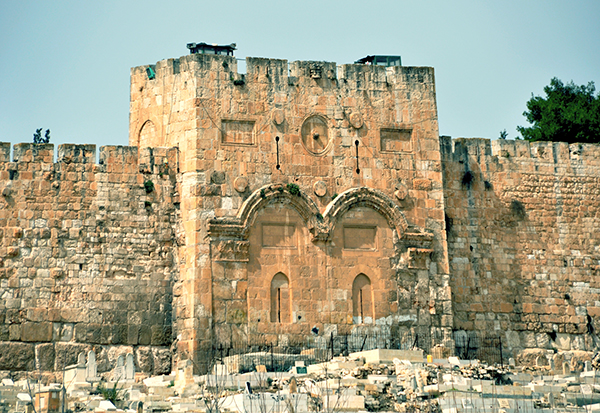
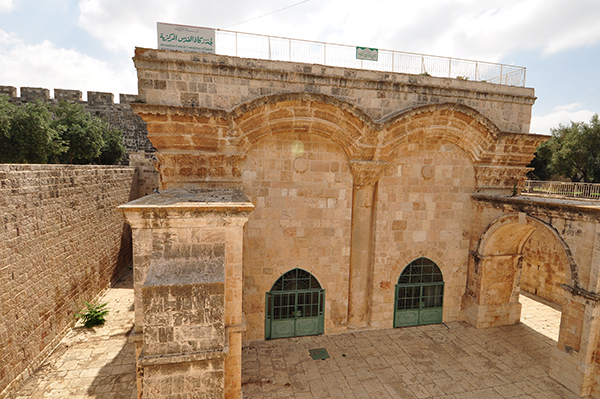
The remains of two massive monolithic gateposts are preserved inside this gate.
The gateposts are set in the same line as the Eastern Wall of the Temple Mount and line up with the massive masonry that can be seen on either side of the Golden Gate.
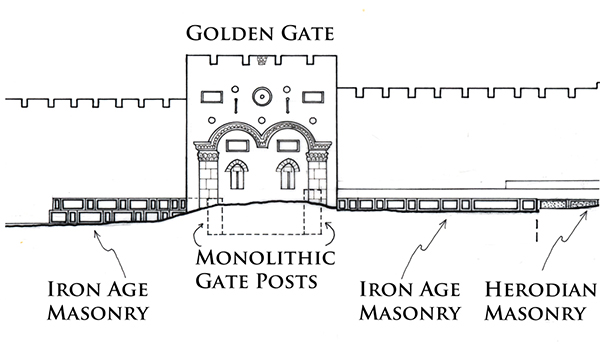
The gateposts and the two masonry sections appear therefore to be part of the same construction. The top of the southern gatepost is level with the top of the ancient masonry that can be seen south of the Golden Gate. The northern gatepost is one stone course higher and is located only one stone course below the surface of the Temple Mount. This means that the top of the original lintel would have been identical with the present-day level of the Temple Mount. The two gateposts belong to a gate that dates from the First Temple period and is most likely the Shushan Gate, mentioned in Mishnah Middot 1.3 as the only gate in the Eastern Wall.
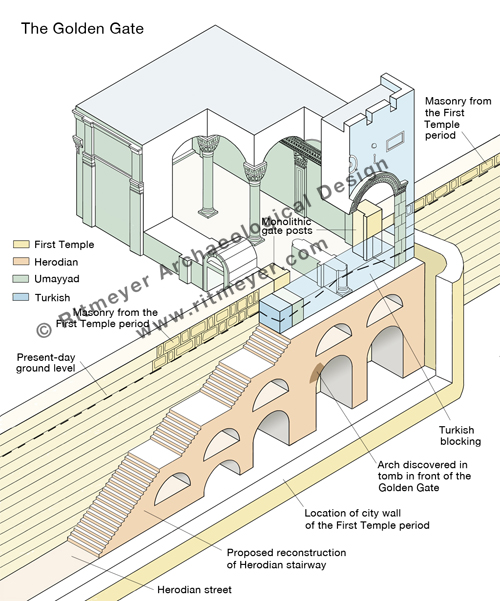
The gate most probably was given this name by builders who had returned from exile in Babylon and for whom the Palace of Shushan lived on in their memories. However, if so there would have been a tradition of an eastern gate in this location from the time of the construction of the original Eastern Wall. It seems reasonable to suggest that the central section of the Eastern Wall dates from the First Temple period, in particular to the time of King Hezekiah. This square mount was extended south in the Hasmonean period, while both the southern and northern additions were made by King Herod the Great.
In 1969, the remains of an underground arch were discovered inside a grave in front of the Golden Gate. It was suggested that this may have been a pre-Herodian gateway. However, as the arch stones appear to be Herodian, it is more reasonable to suggest that this arch was part of a Herodian staircase leading up to the original gate. It is fascinating to contemplate that the stairway may still be intact under this gate, although hidden from sight by the Muslim Cemetery.
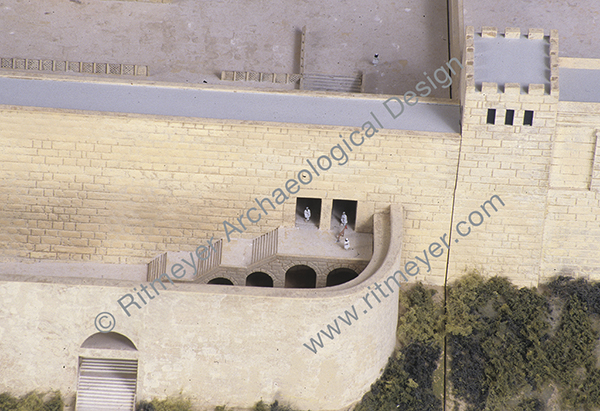
We do know that the remains of an ancient city wall lie under the present-day path that runs through the Muslim cemetery, which was discovered by Warren in the 1860s. The above-mentioned arched stairway led down through a gate in this city wall, the so-called Miphkad (Muster, or Inspection) Gate mentioned in Nehemiah 3.31, apparently still in use in the Second Temple period. During the latter period, it was through these gates that the Red Heifer was led out from the Temple Mount to the Mount of Olives (Mishnah, Parah). On the Day of Atonement, the scapegoat was led by the same route into the wilderness (Mishnah, Yoma).
It is therefore obvious that the Golden Gate is a very important historical building for the Jewish people, as reported by Arnon Segal of the Hebrew newspaper Makor Rishon Here is a translation of the article that refers to my research:
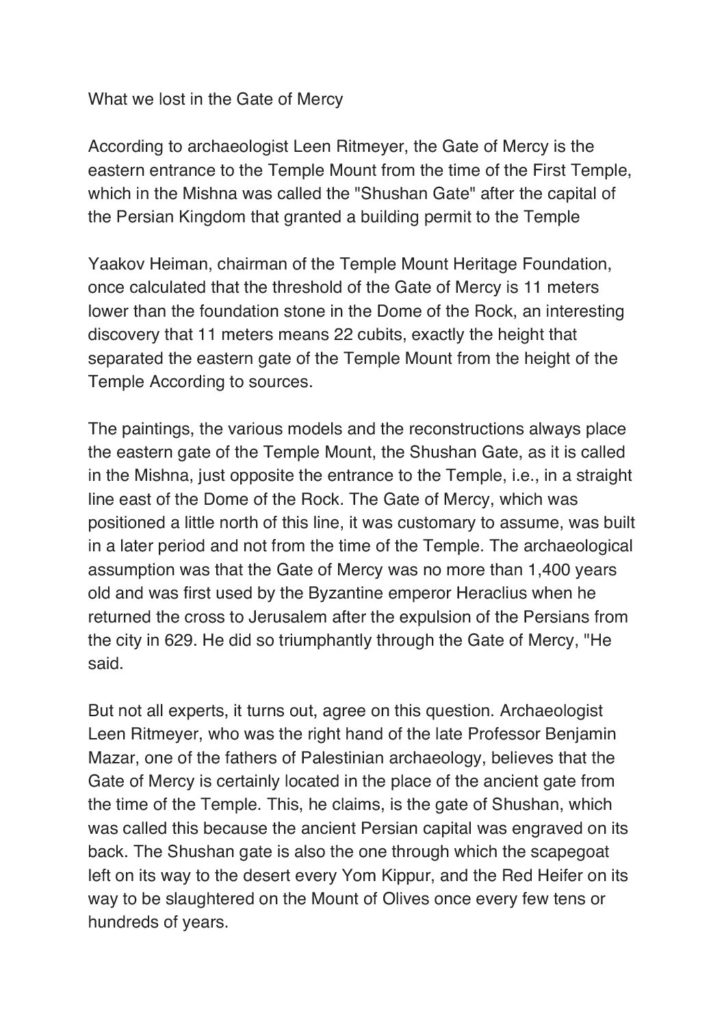
HT: Dr. Eli David

They brought the Red Heifer and Scapegoat up those stairs? I recall reading somewhere that archeologists know where the sacrifices were prepared, why didn’t they use that route?
As usual, thorough, detailed yet clear and uncombersome.
It says in Mishnah Para 3:6,
And they would make a ramp from the temple mount to the mount of anointing [the Mount of Olives], arches on top of arches, and [hollow] domes over the foundations, because of graves of the deep, for on it the priest who would burn the heifer, and the heifer and all its helpers would leave to the mount of anointing.
Thanks Leen for sharing the vintage self-portrait within the gate house. That you were allowed such access to do field drawings is amazing to me. I am assuming you have ALL of those original sketches from that period of work. Perhaps they should be published at some point; you know, a comprehensive record of field drawings of the Temple Mount. (hint hint) Ahhhhh. A lovely coffee table sized volume. I can see it now! But I digress.
Too bad (like every other Waqf-based constraint at the Temple Mount) this section of the Eastern wall surrounding the gate can’t be excavated due to the many Arab graves there. Each time I have visited this ‘cemetery’ I was struck by how trashed and chaotic it appears. Not certain why the locals leave the place so disheveled. Regardless, it is a serious hinderance to proving or disproving what was and still is THERE, just below the surface. Clarifying these details with a dig would be so satisfying. Thank you again for your work.
I still regret that Warren didn’t tunnel all the way to the Golden Gate when he was stopped by the massive city wall remains. However, I expect that there are just more of those First Temple period courses going down to the bedrock. Nevertheless, would love to dig there!
why not not use lydar, the ground pentrating tool, from a drone, to see what’s under the cemetery?
Lidar does not penetrate the ground. Ground penetrating radar could do the job, but as it involves dragging a scanner over the ground, that is impossible under the prewsent circumstances.
Leen Ritmeyer, thanks so much for your article. It’s been really good to read and to understand the gate’s place in both historic and prophetic history.
Could you please explain further on the Muslims ideas?
You wrote:
“Muslims refer to it as the Gate of Eternity (Bab-al-Dahariyeh) and believe it will be an important part of the last judgment of mankind. The Muslim cemetery along the Eastern Wall is thought to have been placed there in the belief that the forerunner of Messiah, Elijah, being of a priestly family, could not pass through the Golden Gate, thus preventing the coming of the Messiah.”
I’m struggling with how I should read this text.
Exactly what is “preventing the coming of the Messiah”?
Do the Muslims believe, that they can prevent the coming of the Messiah, by building a cemetery outside the gate? Or was it built to prevent Elijah from walking through it, and therefore not reaching the gate?
Wouldn’t Elijah, who was taken alive to heaven, return in a glorified body, and as such not under any earthly priestly ceremonial rules?
Why would the Muslims prevent the coming of the Messiah? Do they fear the “last judgement of mankind”? Why do they fear the judgement? Why do they fear the coming of the Messiah?
Thanks for you great work!
I appreciate your thoughts, but to understand this problem, we need to enter into the mind of the people at the time. The people involved were not Christians.
The Golden Gate has been opened and closed a few times. The last one to close the gate was Suleiman the Magnificent in about 1540. Nobody is sure why he did so, but the most wide-spread legend is that he heard the Jews describing the Messiah as a mighty military leader who would enter Jerusalem through the eastern gate and liberate the city from foreign rule.
He heard that Elijah would also come through this gate to announce the coming of the Messiah. As it was believed that Elijah was from priestly stock, Suleiman thought that he could prevent him coming through this gate by closing it and putting a Muslim cemetery in front of the gate. It was believed that no Jewish priest would defile himself by walking through a Muslim cemetery.
but how doest it reconcile what the mishna says that the red hefer was done direct across the eastern gate of the temple to the entrance to the foundation stone?
Yes, that is correct, but you need to take into consideration that the Red Heifer was sacrificed on the top of the Mount of Olives. From there you could see directly through the Nicanor Gate into the eastern gate of the Temple. As the Mount of Olives is such much higher than the Temple Mount, you would look high over the eastern Wall of the Temple Mount. Wherever the eastern gate was located, you could never see the Temple though such a gate, as it was far too low.
thanks!
so what was this gate called in the 1st and 2nd temple era?
Regarding the comment interesting above by ‘amaltra’ . . . without intending to put words into his/her mouth . . . I think the point being made assumes a Mishnaic reference to a line; that is, an axis; from the Most Holy Place (centered on the Foundation Stone), directly perpendicular running east, toward the Har Ha Zeitim (Mount of Olives). It is a precise linear relationship eastward, (although more like 83 degrees – north – of due east), out toward the high summit of the Mt. of Olives. It is in this orientation that the (rare) Red Heifer (purity) sacrifice would have been conducted. Thoughts?
Daniel, not only does Mishnah Parah 3:9 and 4:2 indicate that the blood of the Red Heifer was sprinkled in the direction of the entrance of the Temple, thus, as you say, indicating an axis [see: https://www.ritmeyer.com/product/image-library/illustrating-the-bible/books-of-moses/red-heifer ], but the heifer itself was laid with its head to the south and its face to the west. This means that the face of the Red Heifer was turned to the Temple as well.
Right, Leen. Agreed. Not wanting to ‘beat a dead horse’ as they say . . . but, the question (respectfully still not directly answered) is . . . was the ‘leading out’ of the Red Heifer LITERALLY along the Temple Axis? Because if it was, THAT axis in NOT centered on the Mercy gate. The red axis line shown in your illustration aligns squarely between the Most Holy Place and the Mt. of Olives summit. A ‘Mercy Gate Axis’ (running parallel eastward) is roughly 80 meters north of the ‘Temple Axis’ and not indicated on your illustration. All that to ask this. (a) Was the alleged bridge used for the Red Heifer/Azazel Goat seated across the Kidron, ALIGNED with the ‘Temple Axis’? or . . . (b) was that bridge instead ALIGNED with the ‘Mercy Gate Axis’? Hope this is clear. My question is squarely addressing the idea that came to my mind when I read ‘amaltra’s comment. Also, I am using CAPS for emphasis, since I don’t have access to ITALICS. 😉
its interesting to note that in iron age solomnic gates, were behind other walls like in megiddo or tel dan, chevron. the wall he found was base on such a wall.
Amaltra, no wall was found by James Fleming, only the top of an arch. When discussing his find with him, James agreed that the arch could have supported and arched stairway and conceded that it could not have belonged to an earlier gate, as the bedrock is too steep to accommodate a stairway at such a low level.
Daniel, Mishnah Para 3:6 says this: “They made a causeway from the Temple Mount to the Mount of Olives, an arched way built over an archway, with an arch directly above each pier [of the arch below], for fear of any grave in the depths below. By it the priest that was to burn the Heifer, and the Heifer, and all that aided him went forth to the Mount of Olives.” The Hebrew word for “causeway” is “kevesh” and not bridge (gesher). A kevesh is a ramp that, in this case, began at the eastern gate (Golden gate), descended into the Kedron Valley and possibly up again the Mount of Olives. There is no mention of the direction of the ramp or its distance from the gate. The only direction mentioned is that of the priest who, from the top of the Mount of Olives, sprinkled the blood in the DIRECTION OF THE TEMPLE. The ramp didn’t have to follow this alignment.
Thank you very much for your precisions in this article, Leen.
Best regards !
Jacquy Mengal
I’m so grateful for this article. God bless you Lee! Good work! Thanks from Brazil!